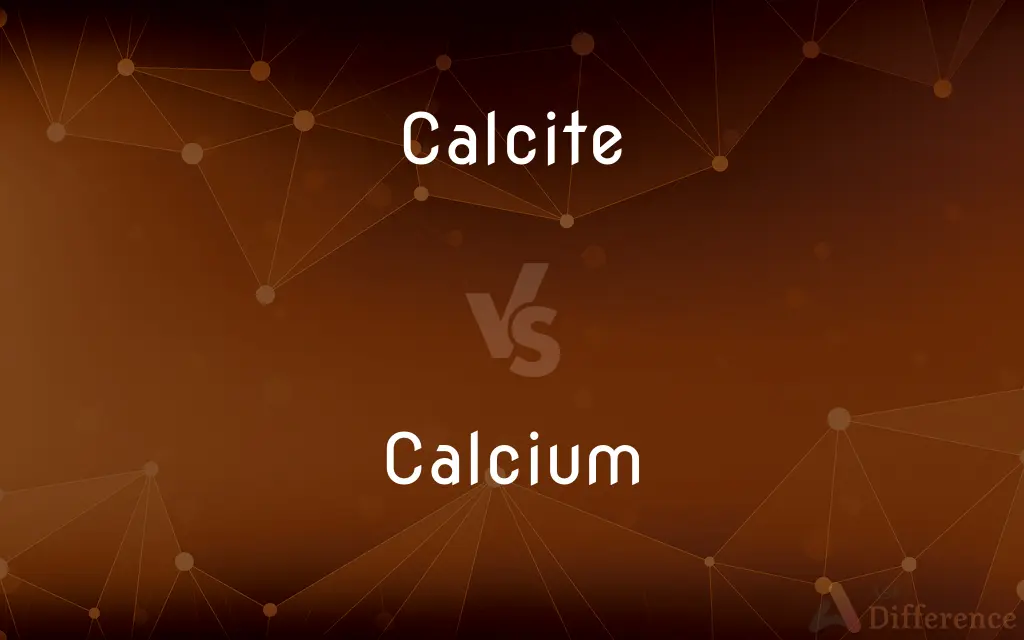Calcite vs. Calcium — What's the Difference?
Edited by Tayyaba Rehman — By Urooj Arif — Updated on April 8, 2024
Calcite is a naturally occurring calcium carbonate mineral, often used in the manufacture of cement and lime, whereas calcium is a chemical element vital for living organisms.

Difference Between Calcite and Calcium
Table of Contents
ADVERTISEMENT
Key Differences
Calcite is a mineral form of calcium carbonate, commonly found in sedimentary, metamorphic, and igneous rocks, acting as a key component in the earth's crust. On the other hand, calcium is an alkaline earth metal, essential for biological systems, including bone and tooth formation in humans.
Calcite is utilized in various industrial applications, including the production of cement and as a neutralizer of acidic conditions in soil and water. Whereas calcium, in its pure elemental form, is used in metallurgy and as a reducing agent in the extraction of other metals.
The optical properties of calcite, such as its birefringence, are exploited in the manufacturing of polarizing microscopes, whereas calcium's properties are harnessed in the creation of strong, lightweight alloys for aerospace and automotive applications.
In the realm of geology, calcite is a primary indicator of carbonate rock formations and plays a crucial role in the carbon cycle. Conversely, calcium's significance extends to its role in the human body, where it regulates vital physiological processes, including muscle function and nerve transmission.
While calcite crystals can display a wide variety of morphologies and colors depending on the impurities present, elemental calcium is a relatively soft, silvery-white metal that reacts vigorously with water.
ADVERTISEMENT
Comparison Chart
Nature
Mineral (Calcium Carbonate)
Chemical Element (Metal)
Applications
Cement production, neutralizing agent, optics
Metallurgy, dietary supplements, medical uses
Optical Properties
Birefringent
Not applicable
Significance in Geology
Indicates carbonate rocks, part of the carbon cycle
Not directly significant
Physical Form
Solid, various colors and morphologies
Silvery-white, soft metal
Compare with Definitions
Calcite
It's a major component of limestone and marble.
The White Cliffs of Dover are composed of calcite.
Calcium
Calcium ions play a vital role in physiological processes.
Calcium is crucial for muscle contraction and nerve function.
Calcite
Calcite is used in the manufacturing of cement.
Crushed calcite is mixed with other materials to produce cement.
Calcium
It's the fifth most abundant element in the Earth's crust.
Calcium compounds are common in various rocks.
Calcite
Calcite is a carbonate mineral with high birefringence.
Calcite crystals are often used in the study of optics.
Calcium
Calcium is an essential element in the human diet.
Dairy products are a primary source of calcium.
Calcite
Calcite reacts with acids to produce carbon dioxide gas.
Geologists use dilute hydrochloric acid to identify calcite rocks.
Calcium
Calcium supplements are used to prevent bone diseases.
Calcium carbonate and calcium citrate are common forms of supplements.
Calcite
It forms in a variety of shapes and colors based on impurities.
The presence of iron in calcite can give it a red hue.
Calcium
As a metal, it's used as a reducing agent in the extraction of other metals.
Calcium is used in the production of chromium and thorium.
Calcite
Calcite is a carbonate mineral and the most stable polymorph of calcium carbonate (CaCO3). The Mohs scale of mineral hardness, based on scratch hardness comparison, defines value 3 as "calcite".
Calcium
Calcium is a chemical element with the symbol Ca and atomic number 20. As an alkaline earth metal, calcium is a reactive metal that forms a dark oxide-nitride layer when exposed to air.
Calcite
A common crystalline form of natural calcium carbonate, CaCO3, that is the basic constituent of limestone, marble, and chalk. Also called calcspar.
Calcium
A silvery, moderately hard alkaline-earth metal that constitutes approximately 3.6 percent of the earth's crust and is a basic component of most animals and plants. It occurs naturally in limestone, gypsum, and fluorite, and its compounds are used to make plaster, quicklime, Portland cement, and metallurgic and electronic materials. Atomic number 20; atomic weight 40.08; melting point 842°C; boiling point 1,484°C; specific gravity 1.54; valence 2. See Periodic Table.
Calcite
(mineral) a very widely distributed crystalline form of calcium carbonate, CaCO3, found as limestone, chalk and marble
Calcium
The chemical element (Symbol Ca), with an atomic number 20. It is a soft, silvery-white alkaline earth metal which occurs naturally as carbonate in limestone and as silicate in many rocks.
Calcite
Calcium carbonate, or carbonate of lime. It is rhombohedral in its crystallization, and thus distinguished from aragonite. It includes common limestone, chalk, and marble. Called also calc-spar and calcareous spar.
Calcium
(countable) An atom of this element.
Calcite
A common mineral consisting of crystallized calcium carbonate; a major constituent of limestone
Calcium
An elementary substance; a metal which combined with oxygen forms lime. It is of a pale yellow color, tenacious, and malleable. It is a member of the alkaline earth group of elements. Atomic weight 40. Symbol Ca.
Calcium
A white metallic element that burns with a brilliant light; the fifth most abundant element in the earth's crust; an important component of most plants and animals
Common Curiosities
What is calcium and why is it important?
Calcium is a chemical element vital for many physiological processes in living organisms, including bone and tooth formation.
How does the body use calcium?
The body uses calcium for bone and teeth structure, muscle function, nerve signaling, and blood clotting.
How are calcite and calcium related?
Calcite is a mineral form of calcium carbonate, thus containing calcium in its chemical structure.
Can calcite be found in everyday products?
Yes, calcite is found in items like toothpaste, plastics, and paper as a filler or extender.
What happens when calcite reacts with acid?
Calcite reacts with acids to produce carbon dioxide, water, and calcium salts.
What is the difference between calcite and limestone?
Calcite is a mineral, while limestone is a sedimentary rock composed primarily of calcite.
Is calcium metal found in its pure form in nature?
Calcium is not found in its pure form in nature due to its reactivity with water and air; it is usually found in compounds.
Can calcium supplements replace dietary calcium?
While supplements can help, dietary sources of calcium are generally recommended for their additional nutritional benefits.
What is calcite used for?
Calcite is primarily used in the production of cements and lime, and as a neutralizer in acidic environments.
What role does calcite play in water treatment?
Calcite is used to neutralize acidic conditions in water treatment processes, improving water quality and pH balance.
What are the sources of calcium in the diet?
Dairy products, leafy greens, and fortified foods are common dietary sources of calcium.
Can you see the birefringence of calcite with the naked eye?
While difficult to see without magnification, the birefringence of calcite can be observed with polarized light sources.
Why is calcium important for plants?
Calcium is essential for plant structure, cell wall stability, and growth.
Are there any health risks associated with calcite?
In its natural form, calcite poses no significant health risks, but inhalation of calcite dust can irritate respiratory pathways.
How is calcium extracted for industrial uses?
Calcium is typically extracted through electrolysis of fused calcium chloride or as a byproduct of the Kroll process.
Share Your Discovery

Previous Comparison
Coup vs. Coupe
Next Comparison
Ambiance vs. EnvironmentAuthor Spotlight
Written by
Urooj ArifUrooj is a skilled content writer at Ask Difference, known for her exceptional ability to simplify complex topics into engaging and informative content. With a passion for research and a flair for clear, concise writing, she consistently delivers articles that resonate with our diverse audience.
Edited by
Tayyaba RehmanTayyaba Rehman is a distinguished writer, currently serving as a primary contributor to askdifference.com. As a researcher in semantics and etymology, Tayyaba's passion for the complexity of languages and their distinctions has found a perfect home on the platform. Tayyaba delves into the intricacies of language, distinguishing between commonly confused words and phrases, thereby providing clarity for readers worldwide.
















































